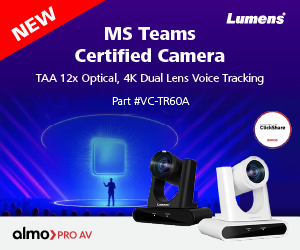by Rob Ziv | Nov 3, 2016 | Uncategorized
One of the questions that comes up frequently is what are the differences between the three current models of ClickShare and which one should I choose.
Below is a chart that lines up the features…
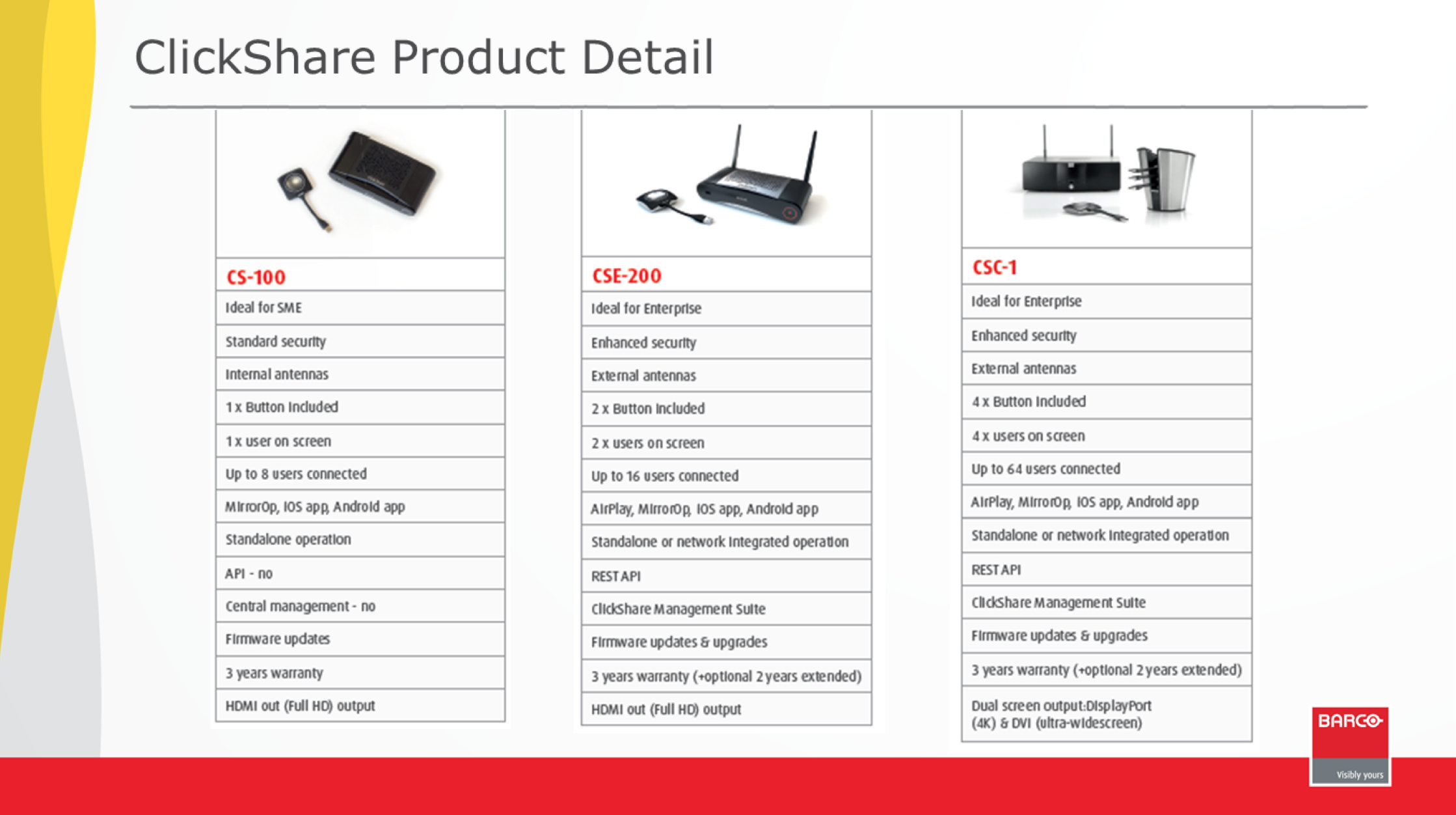
The most common difference that jumps out when looking at the chart is the number of supported buttons and simultaneously supported images. Extra buttons and trays are available for all units, so don’t let the number of included buttons limit the decision process. However, if we look a little deeper, there are some less obvious and potentially more important elements to consider:
If users will have a 4K display, then consider the CSC-1. Even if they will not share 4K content, the CSC-1 allows users to show up to fou
r 1080p sources simultaneously at their native resolution on a single 4K display. (If end users share spreadsheets or other visually detailed content, then this alone may be enough reason to move to a 4K display.) No external scaler required.
On the other end of the spectrum is the budget conscious CS-100 which is great for small businesses and huddle spaces. Many companies choose to move up to the CSE-200 for Airplay compatibility and to allow two users on screen at the same time. For consistency in the end user experience, companies also tend to go with CSE-200 in huddle spaces when a CSC-1 is also used in larger spaces. Both the CSE-200 and CSC-1 allow for network integration, while the CS-100 does not. This combination of price and features has made the CSE-200 the most popular unit, followed closely by the CSC-1.
In addition to our demo loaner program, there is also a dealer demo purchase program that allows integrators to by one of each unit at a discount. Both options are a great way to help you and your customer evaluate options. As always, feel free to contact me or your Almo rep if you have questions.
by Rob Ziv | Nov 3, 2016 | Uncategorized
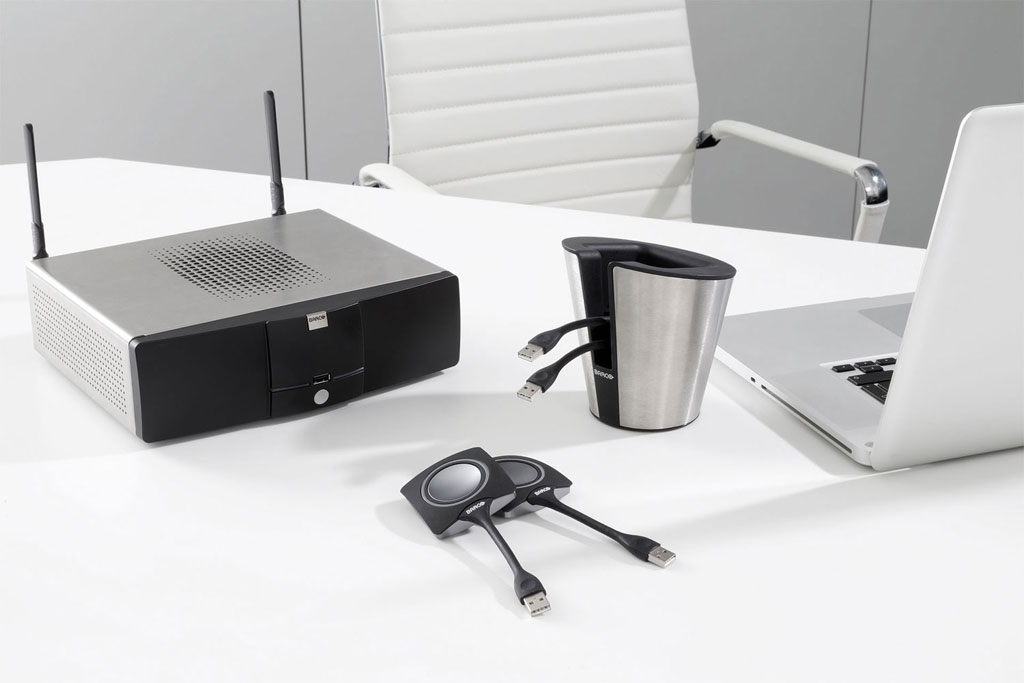 My impressions 60 days after adding Barco to my Business Development Manager responsibilities: there is much more to Barco than ClickShare and projectors. This includes video walls, image processors, video switchers, and beyond. Similar to ClickShare, design elegance and sophistication is consistent. Yet, recent price moves and promotions in some categories keep the products within reach of their target markets.
My impressions 60 days after adding Barco to my Business Development Manager responsibilities: there is much more to Barco than ClickShare and projectors. This includes video walls, image processors, video switchers, and beyond. Similar to ClickShare, design elegance and sophistication is consistent. Yet, recent price moves and promotions in some categories keep the products within reach of their target markets.
ClickShare is still the most popular Barco solution at Almo. If you have not seen ClickShare yet, check out this video (1:15). Customer’s love the simplicity of wireless screen sharing, knowing meetings will run smoothly, and that ClickShare does not require connection to a corporate network (although it is an option). As a bonus, the savings compared to a matrix switch, scaler, and table connectivity are significant.
Since ClickShare creates its own wireless connection in the Wi-Fi band, the integration questions that come up the most relate to managing multiple units in a crowded Wi-Fi space. There a numerous successful installations with literally hundreds of ClickShare units in the same facility and that work glitch free. Much has been written on the subject including white papers and user guides, but some of the high points include:
- ClickShare allows you to manually set the Wi-Fi band, channel, and power of each unit. This allows you to alternate channels between adjacent spaces, dial back power if necessary, and minimize potential interference in a crowded wireless space.
- Change the default SSID and name of each unit to something logical (i.e. the room name).
- Room-specific connection instructions (with SSID) appear on the welcome screen – reducing questions on how to connect.
There are flexible security options making it easy to share content while keeping malicious outside content from hijacking a meeting.
If you have not experienced ClickShare first hand, or would like to dive deeper into configuration options, contact your Almo representative for a 21-day demo loaner unit. Nothing compares to first-hand experience.
by Heather Wagaman | Nov 1, 2016 | Digital Signage, Education, Uncategorized
October finished up the last of the Almo Pro AV E4 AV Tours for 2016, the last of which was in Dallas, TX.
One of the many things to do is walk through the Exhibit Hall, where all of Almo’s manufacturer partners showcase their latest and greatest products…
I really “flipped” over the all-new R Series product displayed by Sharp at our Dallas Show.
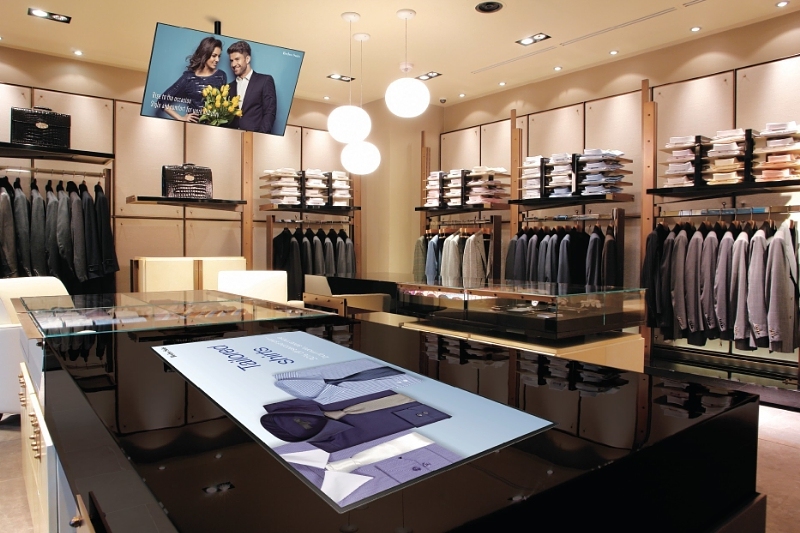
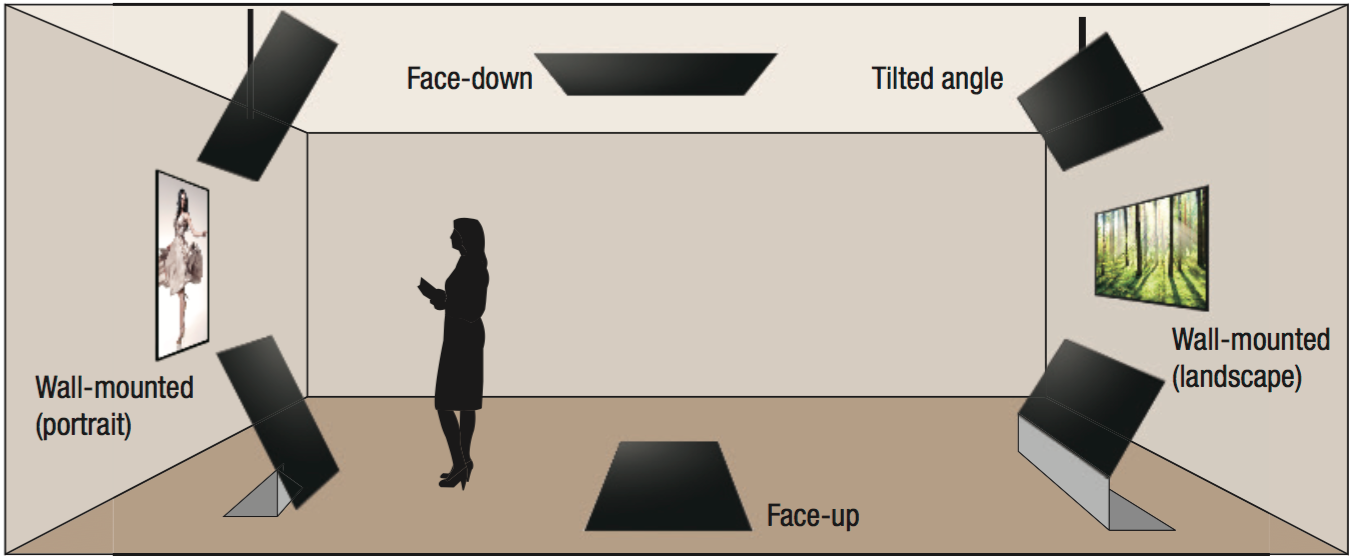 This beauty will come in a 42”, 49” and 55” display, and with the extreme tilt capabilities opens up new mounting possibilities that gives more flexibility than ever before to digital signage installations. My imagination went wild. Not only can this series be mounted in portrait or landscape mode, imagine the 42” display mounted face up on a table in a sleek apparel shop, or the 55” face down from the ceiling in a planetarium…
This beauty will come in a 42”, 49” and 55” display, and with the extreme tilt capabilities opens up new mounting possibilities that gives more flexibility than ever before to digital signage installations. My imagination went wild. Not only can this series be mounted in portrait or landscape mode, imagine the 42” display mounted face up on a table in a sleek apparel shop, or the 55” face down from the ceiling in a planetarium…
While I wouldn’t suggest mounting it on a floor surface that would be walked on, the design of these monitors is robust enough that they can be suspended from the four corners of the rear housing using wires. I immediately envisioned a simple, elegant look for an office lobby, like an attorney’s office or accounting firm or a retail shop where information, daily specials or other content could be simply and beautifully displayed.
The ingenuity and creativity of our dealers and integrator customers is always impressive. And I can’t wait to see what they come up with when they let loose with Sharp’s new PN-R Series!
by Guest Blogger | Oct 7, 2016 | Uncategorized
Hi! I’m Jeff Sanchez.

With my 9-years experience in the Graphic Design Field, I have never encountered a monitor with such spectacular image quality. NEC’s MultiSync EA275UHD is truly an AMAZING display.
To see images at their full potential in high resolution as an artist is very exciting! Everyday at work is awesome now that I get to experience my designs in stunning 4K UHD.
What I really enjoy about it is I went from 23” standard definition display to an amazing 27” UHD display. Now I can view multiple windows very easily, which is a plus particularly in my field. But the mind-blowing part about it is the image resolution it delivers. Just WOW! To view images in 4K is truly magnificent, especially working in Photoshop. It’s like seeing the picture up-close and personal.
Another cool feature I find advantageous is the ability to rotate the monitor into portrait mode, providing nearly 360 degrees of swivel, and 25 degrees of tilt. Now that’s what’s up.
 All-in-all MultiSync EA275UHD is an amazing product that delivers a superior quality making my job more fun, and takes my creativity to a whole new level.
All-in-all MultiSync EA275UHD is an amazing product that delivers a superior quality making my job more fun, and takes my creativity to a whole new level.
by Heather Wagaman | Sep 26, 2016 | News, Uncategorized

There has obviously been a TON of information published, interviews conducted, Web X Meetings, etc, from both inside and outside the channel in regards to the acquisition of IAVI by Almo Pro AV. Now that the dust has settled, and as a 10 year employee and Senior Manager at IAVI before the acquisition, here is a look at the acquisition from (perhaps) a little DIFFERENT perspective.
FIRST THOUGHTS
- “OMG we’ve been bought out by a competitor in the industry”
- “OMG do I have a job?”
- “Oh no, what ARE we going to do?”
Rewind 3 months to April 13th
IAVI was a 19 year old Commercial – Pro A/V Distributor; a veteran so to speak in the channel with HUGE growth percentages year after year since the mid 2000’s. Almo Pro AV, the company that acquired IAVI, was for the last 7 years one of our chief competitors, certainly our rival in the channel and now; they’ve both taken us out of the game and literally taken over in general. The world as WE knew is now totally upside down and “we” have seemingly LOST the battle.
Fast forward… (it’s now the end of September!)
Where are we today?
“We” as the new combined Almo Pro AV have participated in the third of our E4 AV Tour of the year in Boston, exhibited at InfoComm in June, conducted our annual National Sales Meeting in July, and have one more E4 AV Tour shows coming up soon: Dallas on October 18th (SAVE THE DATE!)
Virtually ALL of Almo Corporation and Almo Pro AV Senior Management have visited the new Almo Florida office and have provided the EX IAVI team with their motives for acquiring the company, and their vision for the future. They’ve shared opinions and insights with us in regards to the “best practices” that had been identified early on between the two companies and we’ve watched as they’ve specifically implemented some of the IAVI practices quickly into the NEW combined Almo Pro AV.
The results of the due diligences investigations that took place prior to the acquisition have been shared and many of us have been proud to see our NEW company adopt and implement many IAVI practices into the new combined Almo Pro AV almost immediately.
Those of us that were offered positions at Almo have been extremely impressed with the ongoing thought process of Almo Corporation owners and the executive team in the Pro AV Division digging deep into all of the business practices of the acquired company to make the new combined company even BETTER than the previous two individual organizations.
My hats off to Gene, Roz, and Warren Chaiken, Sam Taylor and the rest of the Almo Pro AV Senior Management team for the care and dedication they demonstrated in trying to FIND ways to retain members of the IAVI Team throughout the entire organization in lieu of finding reasons to let them go.
Many people have told me over the years and especially right after the IAVI acquisition, that Almo is a PEOPLE first company and that they recognize their greatest assets as their employees. As a NEW employee of Almo Pro AV it’s my pleasure to testify to the truth of their words and it’s my pleasure to be a part of such a warm and caring organization. I for one am very PROUD to be a part of this incredible new Almo Pro AV TEAM!
by Rob Ziv | Jul 25, 2016 | Uncategorized
Improving Results with Column Line Arrays
I had a design inquiry come in this week for a sound reinforcement system. Nothing out of the ordinary; basic box of a room, 50 wide, 70 deep, 18’ ceilings, drywall construction, 13 rows of seats on a flat floor. The application is primarily speech reinforcement with the need to occasionally rock out. The designer had selected a fairly common pair of conventional speakers to place left and right in the front of the room. I was asked to take a look at the design just to be a second set of eyes. The speakers they selected would have been fine, but a column line array would have been a better option. While line arrays in general have become the de facto standard for touring sound systems and are common in large format installations, compact and column line arrays seem to be one of the most underutilized speaker configurations. The reason we don’t see more line arrays in small to mid-sized installations even when suitable, is due to several factors.
- Old habits die hard. Point-source systems (conventional speaker boxes) have been around longer.
- The benefits of line arrays are sometimes not fully understood. Some of the benefits include:
- Improved control over vertical dispersion. This minimizes reflections off of ceilings and other structural surfaces thereby improving intelligibility and system performance.
- While point-source speakers adhere to the inverse square law (where direct SPL drops by 6dB every time you double the distance from the source) line arrays only lose 3dB every time you double the distance – at least within the near field. What this means is you may not need to blast people in the front of a room for it to be loud enough to hear further back.
- In some cases, it is possible to aim the sound to target the specific requirements of various locations within a venue. While this is often not available within a compact column line array, it’s worth noting as it relates to line arrays in general.
- The detailed characteristics of line arrays are sometimes not fully understood. I would argue that this applies to point-source boxes as well. Yet there is greater familiarity and hence comfort with the point-source boxes. (See Factor #1 – Old habits die hard)
- Size matters. The longer the array, the tighter the vertical control and the lower the frequency where control is available. If a room is highly reverberant, the recommended height of an array may be significant compared to room height itself.
- End users ignore good audio and think they know what a speaker looks like. Audio is usually noticed most when something doesn’t sound good. So most people ignore the audio system when things are going right. Since column line arrays can sound better than their conventional counterparts in the right application and they do not always look like conventional speakers, most end users would not even know they have seen/heard a column line array unless it was specifically pointed out to them. In many installations, they blend into the architecture and can be less visually obtrusive than conventional boxes – even when stacked relatively high.
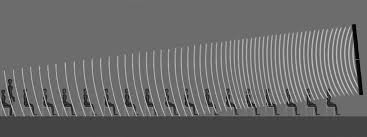
While line array technology has been around for at least fifty years, it would appear from the information above that hesitancy to adopt has more to do with education or experience and less to do with the technology itself. If you work in the installed audio market, consider taking a closer look at column line arrays.
For a quick start, consider the following case study within a highly reverberant House of Worship.
“A Bose Panaray System Tames the Reflections Inside the Thorncrown Chapel”
After that, take a look at some of the products on the market (for example, the Bose MA12EX cited in the case study.) We suggested the Bose MA12 with sub augmentation for the “basic box of a room” mentioned previously.
If you would like to learn more about column line arrays, shoot me an email and we’ll steer you towards additional resources.






 All-in-all MultiSync EA275UHD is an amazing product that delivers a superior quality making my job more fun, and takes my creativity to a whole new level.
All-in-all MultiSync EA275UHD is an amazing product that delivers a superior quality making my job more fun, and takes my creativity to a whole new level.



